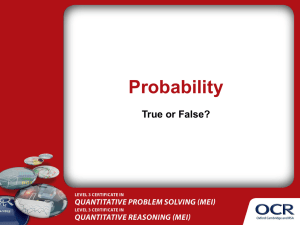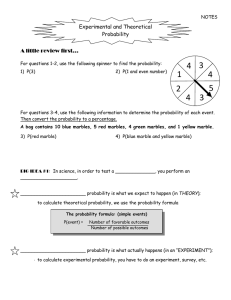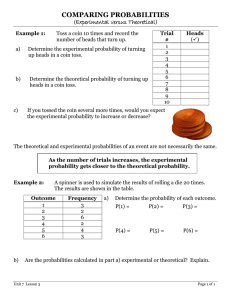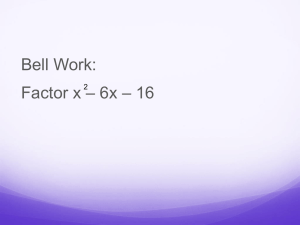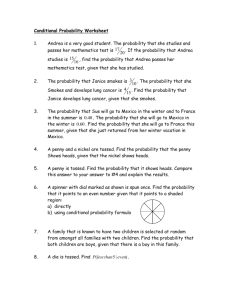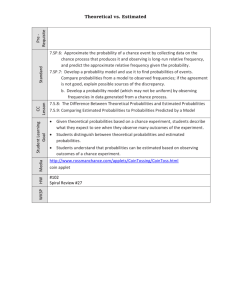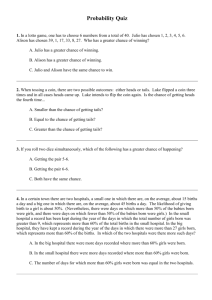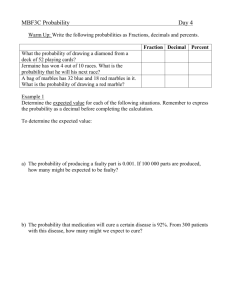Document
advertisement
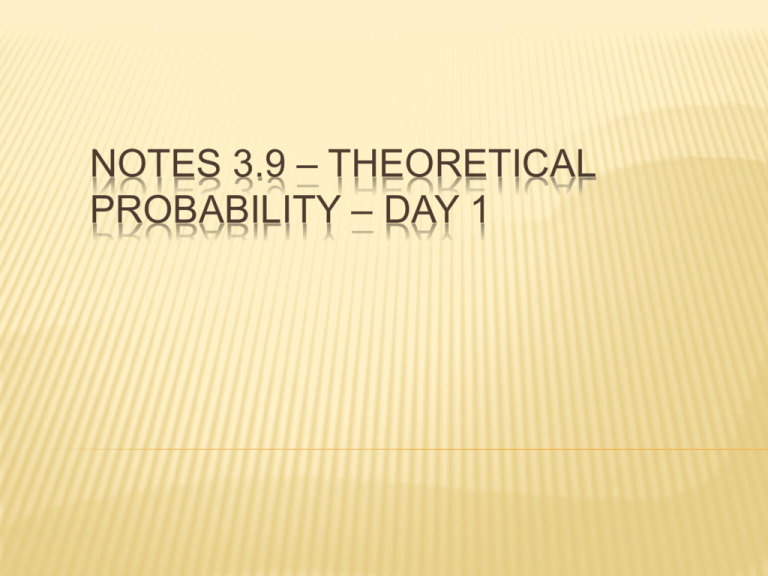
NOTES 3.9 – THEORETICAL PROBABILITY – DAY 1 Each time an experiment such as one toss of a coin, one roll of a dice, one spin on a spinner etc. is performed, the result is called an ___________. OUTCOME Theoretical Probability is a measure of what you ________ EXPECT to occur. A _______________ SAMPLE SPACE for an experiment is the set of possible outcomes for that experiment. Example 1: Create a sample space for the following situation: Mr. And Mrs. Sanderson are expecting triplets. Assume there is an equally likely chance that the Sandersons will have a boy or girl. BBB GBB BGB BBG Total Number of Outcomes: GGB GBG BGG 8 GGG Theoretical Probability = Number of FAVORABLE outcomes in the sample space Number of TOTAL outcomes in the sample space P( E ) FAVORABLE TOTAL Notation: The probability of a certain event occurring P( E ) is notated by _____. Where P stands for _________ probability and E is the ______ event occurring. Example 2 - Using the sample space above, if the couple has 3 children, what is the probability of having 2 boys and 1 girl? P( of 2 boys) = 3 8 P( of 1 boys) = 3 8 P( of 3 girls) = 1 8 P( of 2 girls) = 3 8 Example 3 - Out of 100 families with 3 children how many would you expect to have all girls? 1 P( of 3 girls) = 8 1 n 8 100 8n 100 8n 100 8 8 n 12.5 or about 13 families INDEPENDENT EVENTS: The above situation is an example of an ______________ INDEPENDENT event because the outcome of one event does not affect the probability of the other events occurring. Example 4 - Radcliff is playing a game where he spins the spinner below and tosses 1 2 and coin right after. Create a sample space for all possible outcomes, and 4 3 then answer the questions below. Spinner Coin 1 1 2 2 3 3 4 4 H T H T H T H T 4 1 P(Tails)? 8 2 2 1 P(1)? 8 4 P(1 and Tails)? 1 8 0 0 P(5 and Tails)? 8 2 1 P(Even and Heads)?_______ 8 4 6 3 P(Odd or Heads)? 8 4 MathematicallyAND means we can MULTIPLY each individual probability. OR means we can ADD the probabilities. (But don’t count an event twice!) P(Even and Heads) = P(E) x P(H) = 1 2 1 2 = 1 4 P(Odd or Heads) = P(O) + P(H) - P(O and H) = 1 2 HW : 1 2 Section 3.9 - 1 4 = 3 4 pages 193-194 #’s 6-29 NOTES 3.9 – THEORETICAL PROBABILITY – DAY 2 WITH OR WITHOUT REPLACEMENT Some probability events require the act of ____________ REPLACING an item back before choosing another item. These events are called events _____________________. WITH REPLACEMENT Other probability events require the act of _________________ NOT REPLACING an item before choosing another item. These events are called events ___________ WITHOUT _______________. REPLACEMENT Example 1 - Suppose a bag contains 12 marbles: 6 red (R), 4 Green (G), and 2 yellow (Y). Two marbles are randomly drawn. Use a grid to find the following probabilities: First marble returned First marble not returned (dependent event) (independent event) P(R, then R) P(R, then G) P(R, then Y) P(G, then R) P(G, then G) P(G, then Y) 6 6 1 1 1 12 12 2 2 4 6 4 1 1 1 12 12 2 3 6 6 2 1 1 1 12 12 2 6 12 4 6 1 1 1 12 12 3 2 6 4 4 1 1 1 12 12 3 3 9 4 2 1 1 1 12 12 3 6 18 6 5 12 11 6 4 12 11 6 2 12 11 4 6 12 11 4 3 12 11 4 2 12 11 1 5 5 2 11 22 1 4 2 2 11 11 1 2 1 2 11 11 1 6 2 3 11 11 1 3 1 3 11 11 1 2 2 3 11 33 First marble returned First marble not returned (dependent event) (independent event) P(Y, then R) P(Y, then G) P(Y, then Y) 2 6 1 1 1 12 12 6 2 12 2 4 1 1 1 12 12 6 3 18 2 2 1 1 1 12 12 6 6 36 2 6 1 6 1 12 11 6 11 11 2 4 1 4 2 12 11 6 11 33 2 1 1 1 1 12 11 6 11 66 CARDS A standard deck of playing cards consist of ___ 52 cards. There are __ 26 of each. 2 colors; RED and BLACK. ____ There are __ 4 suits; HEARTS, DIAMONDS, CLUBS, and SPADES. ____ 13 of each. Each suit consist of the cards 2, 3, 4, 5, 6, 7, 8, 9, 10, Jack, Queen, King, and Ace. __ 4 of each. Example 2 - Suppose you are going to pull two cards from a standard deck of 52, one right after the other WITHOUT replacing the first card. Find the following probabilities: 26 26 = 51 1.) P(A red and then a black) = 52 13 51 13 13 = 51 2.) P(Spade and then a Heart) = 52 13 204 4 4 = 3.) P(Jack and then an ACE) = 52 51 26 25 = 51 4.) P(2 Reds) = 52 4 3 = 51 5.) P(2 Kings) = 52 HW : Section 3.9 4 663 25 102 1 221 pages 193-194 #’s 30-45
